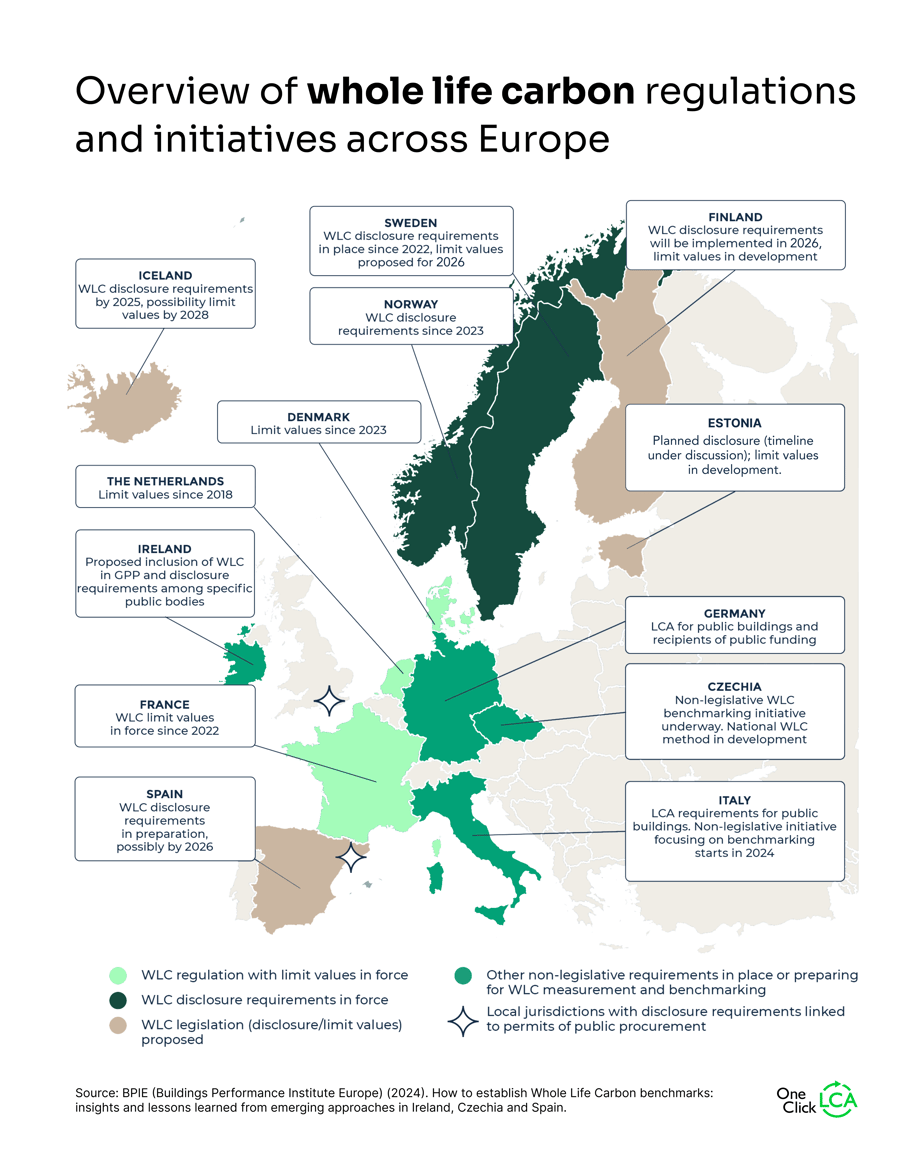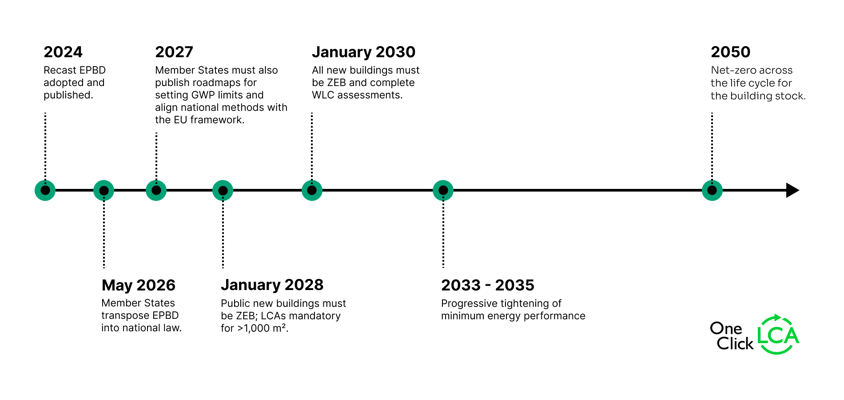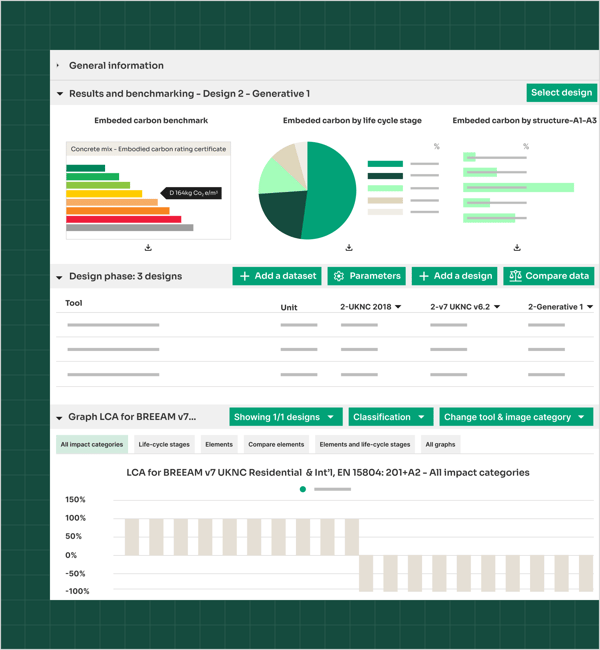
What is EPBD?
The Energy Performance of Buildings Directive (EU) 2024/1275 is the EU’s legislative framework for improving the energy and carbon performance of buildings. First introduced in 2002 and revised several times, the latest recast covers both operational and embodied carbon by requiring whole-life carbon (WLC) assessments and setting minimum energy performance standards. It also phases in zero-emission buildings (ZEBs) and renovation targets for the worst-performing building stock.
How EPBD supports EU climate goals
The European Green Deal sets the EU’s goal of a climate-neutral economy by 2050, supported by the Fit for 55 package, which mandates a 55% reduction in greenhouse gas emissions by 2030 compared with 1990 levels. Within this framework, the Energy Performance of Buildings Directive (EPBD) establishes the legal and technical basis for cutting emissions from buildings — a sector responsible for 40% of total energy consumption, over half of gas use, and 36% of energy-related greenhouse gas emissions. With 85% of the building stock constructed before 2000 and 75% performing poorly in terms of energy efficiency, and with deep renovation rates at only about 1% annually, improving the carbon and energy performance of both new and existing buildings is a central EU priority.
“The recast EPBD is about making carbon measurement mandatory, comparable, and consistent across Europe. It closes the gap between ambition and action by requiring every new building to measure, disclose, and limit its life-cycle carbon.”
— Paul Astle, Building Decarbonization Lead, Ramboll
How EPBD interacts with CPR, CSRD, & ESPR
The EPBD works in alignment with other major policy frameworks:
- EU Taxonomy: Defines sustainable investments and incorporates life-cycle carbon and circularity indicators, referencing Level(s) for Global Warming Potential (GWP) definitions.
- Corporate Sustainability Reporting Directive (CSRD): Requires large firms to disclose embodied carbon, biodiversity impacts, and other ESG metrics.
- Construction Products Regulation (CPR): Mandates product-level carbon footprint data in Declaration of Performance and Conformity (DoPC).
- Carbon Border Adjustment Mechanism (CBAM): Applies carbon pricing to certain imported materials to prevent carbon leakage.
These frameworks together create regulatory alignment across products, buildings, and corporate reporting.
EU taxonomy: The EU Taxonomy defines criteria for life-cycle greenhouse gas (GHG) and circularity requirements for the built environment.
Who does EPBD affect?
- Developers, owners, and design teams delivering new buildings, both public and private, are required to meet ZEB standards and comply with WLC disclosure.
- Public bodies commissioning buildings — earlier ZEB timetable.
- Construction product manufacturers — because building-level WLC pulls in CPR and EN 15804+A2-aligned data via Level(s) and EN 15978.
National implementation strategies
Each Member State must:- Define a national WLC methodology
- Establish rules for reporting, scope, and acceptable data sources
- Implement WLC submission as part of the construction permitting process
- Denmark, France, and the Netherlands already enforce WLC limit values.
- Denmark lowered its thresholds again in 2025, with typology-specific caps.
- Others, including Ireland and Spain, are introducing WLC assessments but without enforceable limits.

How does EPBD work?
EPBD aligns building-level performance (energy and carbon) with a harmonized life-cycle methodology:- WLC calculation & disclosure for new buildings using EN 15978 methods and Level(s) framework for indicator 1.2.
- ZEB performance requirements phased by building type and date (see timeline).
- Renovation of the worst-performing non-residential stock and energy use reduction targets for the residential stock.
- Modernization & digitalization via building automation, smart readiness, and IEQ safeguards.
EPBD timeline & enforcement roadmap

- 2024 — Recast EPBD adopted and published.
- May 2026 — Member States transpose EPBD into national law.
- 2027 — Member States must also publish roadmaps for setting GWP limits and align national methods with the EU framework.
- Jan 2028 — Public new buildings must be ZEB; LCAs mandatory for >1,000 m².
- Jan 2030 — All new buildings must be ZEB and complete WLC assessments.
- 2033–2035 — Progressive tightening of renovation targets.
- 2050 — Net-zero across the life cycle for the building stock.
“2030 sounds far away, but it’s not. With the changes required across the industry, we need to act now to build the literacy, data, and design capacity for whole-life carbon compliance.”
— Paul Astle, Building Decarbonization Lead, Ramboll
Key focus of the revised EPBD
1. Mandatory whole-life carbon disclosure
For the first time, the EPBD mandates whole-life carbon (WLC) reporting for new buildings — including embodied carbon and operational energy.| Date | Requirement |
|
Jan 2028 |
LCAs required for new buildings >1,000 m². |
| Jan 2030 | LCAs required for all new buildings. |
Key requirements:
- GWP must be calculated over the full life cycle — according to EN 15978 and the EU Level(s) framework.
- Reporting must follow Indicator 1.2 of the Level(s) for GWP.
- GWP results must be disclosed on the Energy Performance Certificate (EPC).
- While there are currently no EU-wide GWP limits, Member States shall introduce threshold values in their national building codes.
EPBD & the Level(s) framework
The Level(s) framework, developed by the European Commission, underpins the new carbon disclosure rules. It provides a harmonized method for calculating whole-life carbon in new buildings. Under the revised EPBD, professionals are to calculate and report GWP using Level(s) Indicator 1.2._Timeline.png?width=960&height=657&name=Clearupdate_Level(s)_Timeline.png)
Top LCA software 2025: Compare leading LCA software solutions by features, compliance, and use cases.
2. Renovation and decarbonization of existing buildings
The EPBD recast introduces a coordinated strategy for renovating and decarbonizing existing buildings, aligning carbon disclosure with energy efficiency, modernization, and digitalization targets.Member States must:
- Renovate at least 16% of the worst-performing non-residential buildings by 2030, rising to 26% by 2033.
- Reduce residential energy use by 16% by 2030 and 20–22% by 2035, with at least half of savings coming from the least efficient homes.
CNCA X One Click LCA guide: Learn how refurbishing buildings can reduce embodied carbon emissions compared to demolition and new construction.
3. Zero-emission new buildings
The directive establishes zero-emission buildings (ZEB) as the new standard for all new construction. Requirements include:- ZEB baseline: All new buildings must meet zero-emission criteria based on local climate and cost-optimal levels.
- Solar readiness: All new buildings must be designed to accommodate photovoltaic or solar thermal systems.
- Gradual fossil fuel phase-out: From January 2025, Member States must end subsidies for stand-alone fossil-fuel boilers. Phased installation bans may follow in national legislation.
- Mandatory upgrades in existing non-residential buildings: Solar energy systems should be installed where technically and economically feasible.
4. Modernization and digitalization
The EPBD mandates improved building performance through technical measures:- Building automation and control systems are now required in many non-residential buildings.
- Indoor environmental quality (IEQ) must be addressed in both new builds and major renovations.
- Smart technologies must enable energy monitoring and performance optimization over time.
How does EPBD affect the building and manufacturing sector?
1. Demand for life-cycle assessment will accelerate
Building professionals must now perform LCAs on nearly all new projects, preferably from the concept design stage. This will:- Drive rapid growth in demand for automated, AI-powered LCA tools
- Increase reliance on standardized, machine-readable carbon data
- Push design teams to optimize for embodied and operational carbon within fixed regulatory limits
All-in-one LCA software: to reduce embodied carbon in your projects and comply with EPBD.
2. Product manufacturers will need verifiable data
Architects and engineers will require third-party-verified EPDs that are:- Aligned with global and regional standards
- Integrated into LCA and BIM tools
- Structured for automated performance reporting
EPDs: What are environmental product declarations (EPDs), why you need them, and how to create them.
How One Click LCA supports EPBD compliance
One Click LCA enables AEC professionals and manufacturers to meet EPBD requirements efficiently:- Whole-life carbon assessment aligned with EN 15978 and Level(s) Indicator 1.2.
- Automated LCA from BIM and quantity take-offs to cut manual work and speed submissions.
- Integrated EPD data (generic and verified) and machine-readable outputs for EPCs and reports.
- Early-stage design tools, such as Carbon Designer 3D, are used to model options before detailed specifications are finalized.
These capabilities are used globally across major EU, national, and voluntary frameworks.
Guide: Reduce embodied carbon early in the design process with Carbon Designer 3D.

Key takeaways
-
EPBD (EU 2024/1275) mandates whole-life carbon (WLC) reporting for all new buildings by 2030.
-
Requires zero-emission buildings (ZEBs) from 2028 (public) and 2030 (all).
-
Member States must set renovation targets and introduce GWP thresholds.
-
Based on EN 15978 and Level(s) Indicator 1.2 frameworks.
-
Applies to architects, engineers, developers, and product manufacturers.
Short course: Learn about the recast EU Energy performance of building directive and how to report whole life cycle GWP using One Click LCA.
FAQ — Frequently asked questions about EPBD
Will the EU framework for national calculation clash with existing national methods (e.g., Denmark)?
No. The EU framework sets a common foundation and allows more detailed national approaches within it. Minor adjustments may be needed, but the intent is harmonization, not replacement.
Do we need to wait until 2027 for minimum GWP limits before setting targets?
No. Regulations define the floor, not the ambition. Set and work to internal carbon targets now to build capability and accelerate reductions.
Will there be cut-off rules for small product contributions in building LCAs?
Likely, but details depend on the forthcoming EU methodology update. Regardless, focus effort on the largest sources of carbon — precision on trivial items does not deliver material reductions.
Is EPBD expected to be adopted in the UK?
The UK is considering similar requirements through its own regulatory pathway. Expect movement toward building-level carbon assessment, but under UK instruments rather than EPBD.
Does One Click LCA support EPBD compliance?
Yes. One Click LCA enables AEC professionals and manufacturers to prepare EPBD compliant submissions efficiently:
- Whole-life carbon assessment aligned with EN 15978 and Level(s) Indicator 1.2, the methodology required for reporting global warming potential under the revised EPBD.
- Automated LCA from BIM models and quantity take-offs reduces manual work and accelerates compliance workflows for design teams.
- Integrated EPD data and machine-readable outputs support the use of both generic and verified datasets, including export formats suitable for national EPC systems and compliance reporting.
- Early-stage design tools such as Carbon Designer 3D allow rapid modelling of structural and material options before specifications are locked in, helping teams stay within EPBD carbon targets.
No. CPR obligations are accelerating the need for robust EN 15804 EPDs. EPDs remain the primary, verifiable source for product-level impacts used in building LCAs and EPBD reporting.
Carbon Experts Newsletter
Industry news & insights — straight to your inbox
Resources
Keen to read more?
Read more about the topic
Melina Zacharia • Feb 05 2024
Melina Zacharia • May 06 2025
Melina Zacharia • Jul 18 2025
Asha Ramachandran • Mar 13 2024
